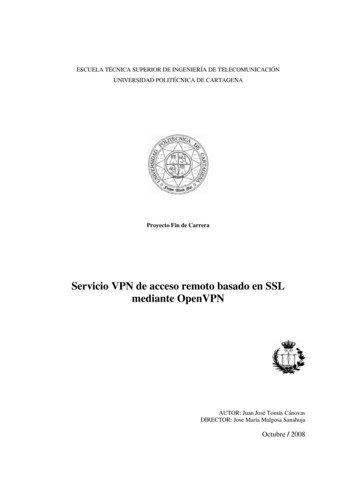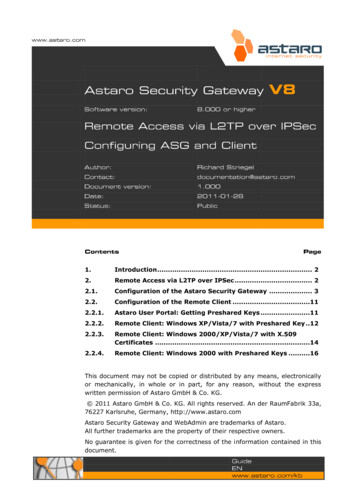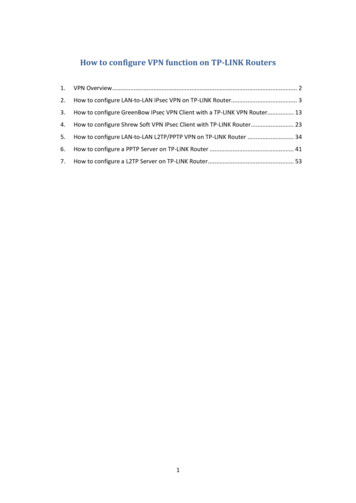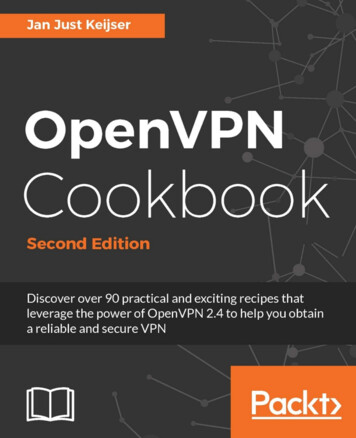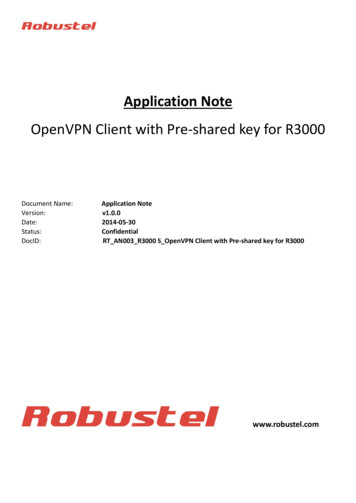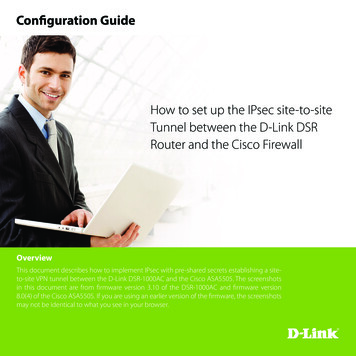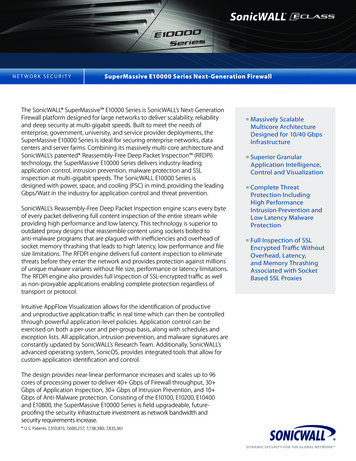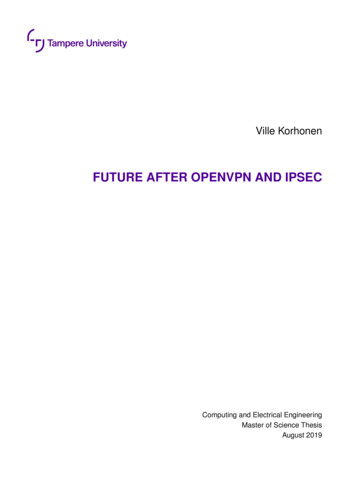
Transcription
Ville KorhonenFUTURE AFTER OPENVPN AND IPSECComputing and Electrical EngineeringMaster of Science ThesisAugust 2019
iABSTRACTVille Korhonen: Future after OpenVPN and IPsecMaster of Science ThesisTampere UniversityMaster’s Degree In Information TechnologyAugust 2019Virtual private networks (VPN) are used to connect private networks of organizations securelyover public Internet. Virtual private network offers a secure and encrypted network connectioneven though the underlying network is public and insecure. In addition to connecting two remotesites with a virtual private network, it is possible to create a virtual private network between aremote worker and an organization site. Virtual private networks allow organizations to buildsecure connections relatively cheap and flexibly over the Internet.The most widely used virtual private network protocols are IPsec (Internet Protocol Security)and SSL/TLS (Secure Socket Layer/Transport Layer Security) based protocols. IPsec is usuallyused for connecting two remote sites and SSL/TLS based technologies are used when a remoteworker connects to the organization’s resources. Both of these protocols have held a strong position for years even though especially IPsec have been criticized since the day it was born. Thegoal of this thesis was to investigate are there any alternatives available currently for IPsec andSSL/TLS based virtual private networks and are there protocols or architectures under development which could be alternatives in the future.Based on the research, IPsec and SSL/TLS based protocols have superseded all older technologies and there aren’t any real alternatives available to them. Many of the network devicesmanufacturers have IPsec based proprietary technologies which try to fix the issues of IPsec butthey are not compatible with the technologies and products of other manufacturers. Out of thenew protocols, Wireguard is promising and it might have a chance to challenge IPsec in the future. Software-defined networks (SDN) and software-defined perimeter (SDP) can also challengetraditional IPsec and SSL/TLS based virtual private networks when those solutions develop andbecome more common.Keywords: VPN, IPsec, OpenVPNThe originality of this thesis has been checked using the Turnitin OriginalityCheck service.
iiTIIVISTELMÄVille Korhonen: Tulevaisuus OpenVPN:n ja IPsecin jälkeenDiplomityöTampereen yliopistoTietotekniikan diplomi-insinöörin tutkinto-ohjelmaElokuu 2019Virtuaalisia erillisverkkoja (virtual private network, VPN) käytetään yhdistämään yritysten sisäverkkoja turvallisesti julkisen Internetin yli. Virtuaalinen erillisverkko tarjoaa turvallisen ja salatun verkkoyhteyden vaikka alla oleva verkko on julkinen ja turvaton. Kahden toimipisteen yhdistämisen lisäksi virtuaalinen erillisverkko voidaan muodostaa esimerkiksi työntekijän ja yrityksentoimipisteen välille. Virtuaalisten erillisverkkojen ansiosta organisaatiot voivat rakentaa yhteyksiäedullisesti ja joustavasti Internetin päälle.Yleisimmät virtuaalisissa erillisverkoissa käytettävät protokollat ovat IPsec (Internet ProtocolSecurity) ja SSL/TLS (Secure Socket Layer/Transport Layer Security)-pohjaiset protokollat. IPsec protokollaa käytetään yleensä yritysten toimipisteiden yhdistämiseen toisiinsa ja SSL/TLSpohjaisia tekniikoita käytetään, kun työntekijä ottaa etäyhteyden organisaation resursseihin. Molempien asema on ollut hyvin vakaa jo useita vuosia, vaikka varsinkin IPseciä on kritisoitu sensyntymästä lähtien. Tässä diplomityössä pyrittiinkin selvittämään, onko IPsecille sekä SSL/TLSpohjaisille virtuaalisille erillisverkoille olemassa vaihtoehtoja ja onko kehitteillä protokollia tai arkkitehtuureja, jotka voisivat tulevaisuudessa olla vaihtoehtoja.Selvityksen perusteella IPsec ja SSL/TLS-pohjaiset protokollat ovat syrjäyttäneet kaikki muutvanhemmat teknlogiat eikä niille ole ollut juurikaan vaihtoehtoja. Useilla verkkolaitevalmistajillaon omia IPsec pohjaisia ratkaisuja, jotka pyrkivät paikkaamaan IPsecin ongelmia, mutta niidenongelma on yhteensopimattomuus muiden valmistajien tekniikoiden ja laitteiden kanssa. Uusistaprotokollista Wireguard on kuitenkin lupaava ja sillä voi olla mahdollisuus haastaa IPsec tulevaisuudessa. Lisäksi ohjelmisto-ohjatut verkot (software-defined networking, SDN) sekä ohjelmistoohjattu ulkoreuna (software-defined perimeter, SDP) voivat tekniikan kehittyessä ja yleistyessähaastaa perinteiset IPsec ja SSL/TLS-pohjaiset erillisverkkototeutukset.Avainsanat: VPN, IPsec, OpenVPNTämän julkaisun alkuperäisyys on tarkastettu Turnitin OriginalityCheck -ohjelmalla.
iiiPREFACEThis thesis was done to the faculty of Computing and Electrical Engineering. I would liketo thank Markku Vajaranta for the topic of this thesis and helping with the initial planning.I would also like to thank Marko Helenius and Evgeny Kucheryavy who reviewed thisthesis.Throughout the years spent in the university, I have spent several hours in TeLE’s guildroom. Thanks to the guild and people of it, my studies, work and social life have beenin balance. I would also like to give special thanks Noora Hartikainen who provided themuch needed peer pressure and peer support during the writing process.In Tampere, 25th August 2019Ville Korhonen
ivCONTENTS1 Introduction . . . . . . . . . . . . . . . . . . . . . . . . . . . . . . . . . . . . . . .12 VPN tunnels . . . . . . . . . . . . . . . . . . . . . . . . . . . . . . . . . . . . . .22.1 Techniques . . . . . . . . . . . . . . . . . . . . . . . . . . . . . . . . . . . .22.2 IPsec . . . . . . . . . . . . . . . . . . . . . . . . . . . . . . . . . . . . . . .32.2.1 AH and ESP headers . . . . . . . . . . . . . . . . . . . . . . . . . .42.2.2 ESP authentication and encryption algorithms6. . . . . . . . . . . .2.2.3 Security Associations . . . . . . . . . . . . . . . . . . . . . . . . . . 112.2.4 Security association and key management . . . . . . . . . . . . . . 112.3 SSL VPN . . . . . . . . . . . . . . . . . . . . . . . . . . . . . . . . . . . . . 142.3.1 TLS protocol . . . . . . . . . . . . . . . . . . . . . . . . . . . . . . . 152.3.2 SSL VPN Architecture . . . . . . . . . . . . . . . . . . . . . . . . . . 162.4 PPTP . . . . . . . . . . . . . . . . . . . . . . . . . . . . . . . . . . . . . . . 172.5 L2TP . . . . . . . . . . . . . . . . . . . . . . . . . . . . . . . . . . . . . . . . 183 VPN Solutions . . . . . . . . . . . . . . . . . . . . . . . . . . . . . . . . . . . . . 203.1 Commercial solutions . . . . . . . . . . . . . . . . . . . . . . . . . . . . . . 203.1.1 Cisco . . . . . . . . . . . . . . . . . . . . . . . . . . . . . . . . . . . 203.1.2 Juniper . . . . . . . . . . . . . . . . . . . . . . . . . . . . . . . . . . 253.1.3 Pulse Secure . . . . . . . . . . . . . . . . . . . . . . . . . . . . . . . 283.1.4 Checkpoint . . . . . . . . . . . . . . . . . . . . . . . . . . . . . . . . 293.1.5 Fortinet . . . . . . . . . . . . . . . . . . . . . . . . . . . . . . . . . . 293.1.6 Palo Alto Networks . . . . . . . . . . . . . . . . . . . . . . . . . . . . 303.2 Open source solutions . . . . . . . . . . . . . . . . . . . . . . . . . . . . . . 313.2.1 OpenVPN . . . . . . . . . . . . . . . . . . . . . . . . . . . . . . . . . 313.2.2 IPsec . . . . . . . . . . . . . . . . . . . . . . . . . . . . . . . . . . . 323.3 Comparison . . . . . . . . . . . . . . . . . . . . . . . . . . . . . . . . . . . . 334 Future . . . . . . . . . . . . . . . . . . . . . . . . . . . . . . . . . . . . . . . . . . 354.1 SoftEther . . . . . . . . . . . . . . . . . . . . . . . . . . . . . . . . . . . . . 354.2 WireGuard . . . . . . . . . . . . . . . . . . . . . . . . . . . . . . . . . . . . 374.3 SDN and SD-WAN . . . . . . . . . . . . . . . . . . . . . . . . . . . . . . . . 404.4 SDP . . . . . . . . . . . . . . . . . . . . . . . . . . . . . . . . . . . . . . . . 425 Discussion . . . . . . . . . . . . . . . . . . . . . . . . . . . . . . . . . . . . . . . 446 Conclusion . . . . . . . . . . . . . . . . . . . . . . . . . . . . . . . . . . . . . . . 47References . . . . . . . . . . . . . . . . . . . . . . . . . . . . . . . . . . . . . . . . . 48
vLIST OF FIGURES2.1 Authentication Header . . . . . . . . . . . . . . . . . . . . . . . . . . . . . . .42.2 ESP in transport mode . . . . . . . . . . . . . . . . . . . . . . . . . . . . . . .52.3 ESP in tunnel mode . . . . . . . . . . . . . . . . . . . . . . . . . . . . . . . .52.4 ESP format . . . . . . . . . . . . . . . . . . . . . . . . . . . . . . . . . . . . .62.5 CBC mode encryption . . . . . . . . . . . . . . . . . . . . . . . . . . . . . . .72.6 CBC mode decryption . . . . . . . . . . . . . . . . . . . . . . . . . . . . . . .82.7 CTR mode encryption . . . . . . . . . . . . . . . . . . . . . . . . . . . . . . .92.8 CTR mode decryption . . . . . . . . . . . . . . . . . . . . . . . . . . . . . . .92.9 AES-GCM encryption . . . . . . . . . . . . . . . . . . . . . . . . . . . . . . . 102.10 IKE SA INT exchange with cookie challenge . . . . . . . . . . . . . . . . . . . 132.11 IKE AUTH exchange . . . . . . . . . . . . . . . . . . . . . . . . . . . . . . . . 132.12 TLS Handshake message flow . . . . . . . . . . . . . . . . . . . . . . . . . . . 162.13 L2TP packet containing an IP datagram . . . . . . . . . . . . . . . . . . . . . . 182.14 L2TP datagram encrypted with IPsec . . . . . . . . . . . . . . . . . . . . . . . 193.1 Hub-and-spoke configuration . . . . . . . . . . . . . . . . . . . . . . . . . . . . 223.2 Spoke-to-spoke configuration . . . . . . . . . . . . . . . . . . . . . . . . . . . 233.3 GETVPN architecture . . . . . . . . . . . . . . . . . . . . . . . . . . . . . . . 243.4 Hub-and-spokes topology with NHTB . . . . . . . . . . . . . . . . . . . . . . . 263.5 OpenVPN multiplex model . . . . . . . . . . . . . . . . . . . . . . . . . . . . . 324.1 SoftEther topology with cascading connection between office and data center . . . 364.2 Overview of handshake process in WireGuard when cookie is not used . . . . . . 384.3 Overview of handshake process in WireGuard when cookie is used . . . . . . . . 384.4 SDN architecture . . . . . . . . . . . . . . . . . . . . . . . . . . . . . . . . . . 414.5 SDP architecture . . . . . . . . . . . . . . . . . . . . . . . . . . . . . . . . . . 43
viLIST OF TABLES3.1 Routing and NHTB tables . . . . . . . . . . . . . . . . . . . . . . . . . . . . 263.2 Comparison of proprietary VPN solutions . . . . . . . . . . . . . . . . . . . 34
viiLIST OF SYMBOLS AND ABBREVIATIONSADVPNAuto Discovery VPNAESAdvanced Encryption StandardAHAuthentication HeadeATMAsynchronous Transfer ModeCBCCipher Block ChainingCCMCounter with CBC-MACCTRCounter modeDESData Encryption StandardDMVPNDynamic Multipoint VPNDNSDomain Name SystemDTLSDatagram Transport Layer SecurityEAPExtensible Authentication ProtocolESPEncapsulated Security PayloadFDBForwarding DatabaseGCMGalois/Counter ModeGDOIGroup Domain of InterpretationGETVPNGroup Encrypted VPNGREGeneric Routing EncapsulationHMACHashed Message Authentication CodeICMPInternet Control Message ProtocolICVIntegrity Check ValueIETFInternet Engineering Task ForceIKEInternet Key ExchangeIPInternet ProtocolIPsecInternet Protocol SecurityL2TPLayer 2 Tunneling ProtocolLDAPLightweight Directory Access ProtocollsvpnLarge Scale VPNMACMessage Authentication Code
viiimGREmultipoint Generic Routing EncapsulationMPLSMultiprotocol Label SwitchingMPPEMicrosoft Point-to-Point EncryptionMSCHAPMicrosoft Challenge Handshake Authentication ProtocolNATNetwork Address TranslationNBMANon-Broadcast Multi-AccessNHCNext Hops ClientNHRPNext Hop Resolution ProtocolNHSNext Hop ServerNISTNational Institute of Standards and TechnologyOCVPNOverlay Controller VPNPKIPublic Key InfrastructurePPPPoint-to-Point ProtocolPPTPPoint-to-Point Tunneling ProtocolRC4Rivest Cipher 4RFCRequest For CommentsSASecurity AssociationSD-WANSoftware Defined Wide Area NetworkSDNSoftware Defined NetworkingSDPSoftware Defined PerimeterSNMPSimple Network Management ProtocolSPDSecurity Policy DatabaseSPISecurity Parameter IndexSSLSecure Socket LayerSSTPSecure Socket Tunneling ProtocolTCPTransmission Control ProtocolTLSTransport Layer SecurityUDPUser Datagram ProtocolVPNVirtual Private Network
11 INTRODUCTIONToday’s organizations are heavily utilizing networked resources and services. These services and resources are rarely hosted in the offices or all sites, but instead they can behosted in own or partner’s data centers or in multiple clouds. Most of the services can’tbe publicly available in the Internet so employees need to have a secure and limited wayto access the resources from the offices and often even from home or other remote locations. To make these connections between sites and users possible and secure, virtualprivate networks (VPN) were invented.IPsec and SSL/TLS based protocols are the most widely used protocols today [93]. Theyare relatively old protocols and the currently used VPN architectures which are based onthem were developed in time before cloud based services started to appear. Therefore,they have some issues with scalability and security [26, 90].This thesis was written to find out if there are any alternatives to the widely used IPsecand SSL/TLS protocols. Previous research about new alternatives was not found as theprevious research has concentrated mainly on security and performance issues of IPsecand SSL/TLS VPNs and comparing these two protocols [4, 26, 50]. Upcoming protocolsand new architecture models under development which could supersede the currentlyused protocols in the future were also explored in this thesis. The thesis was made as aliterature review.The thesis has six chapters. Chapter 2 covers the theory of IPsec and other commonlyused protocols. In Chapter 3, we explore currently available and most widely used commercial and open source VPN solutions. Chapter 4 is dedicated covering the future technologies which are already available and under development. Discussion about the futuretechnologies and current situation is carried out in the Chapter 5 and final conclusionsare in Chapter 6.
22 VPN TUNNELSVirtual private networks (VPN) are commonly used to interconnect private networks acrossthe Internet as they allow users to send and receive data securely between remote private networks. Virtual private network connections can be built, for example, between tworemote sites of an organization (site-to-site VPN) or between user and the organization(point-to-point VPN).Site-to-site VPNs allow organizations to interconnect their offices over the Internet whichis less expensive and more flexible than building dedicated network connections acrosslong distances. When two sites are connected with VPN, computers and users in bothsites are able to securely connect to resources in private networks of the other site.Point-to-point VPNs are usually used by users, who need to access resources securelyin their organization’s private network from outside of their organization’s network. Pointto-point VPNs allow employees to work from homes and other remote locations so pointto-point VPNs are widely used by all kinds of companies and organizations.Usually, the purpose of a VPN connection is to ensure authenticity, integrity and confidentiality of the network traffic. When those three things are fulfilled, the connection is privateand secure which means attackers can’t eavesdrop, tamper or spoof traffic between VPNendpoints. How authenticity, integrity and confidentiality are achieved, depends on theused VPN technique.2.1 TechniquesThe two most common techniques for building virtual private networks are Internet Protocol Security (IPsec) and Secure Socket Layer Virtual Private Networks (SSL VPN). IPsecis usually used for building site-to-site connections and SSL VPNs are often used by remote users to create a point-to-point connection between their workstation and networkof their organization.There are also other techniques like Point-to-point Tunneling Protocol (PPTP) and Layer2 Tunneling Protocol (L2TP) but they are not so widely used as IPsec and various SSLVPNs.
32.2 IPsecInternet Protocol Security (IPsec) is a stack of protocols which is officially specified bythe Internet Engineering Task force (IETF) in several Request for Comments (RFC) documents. It is used to secure Internet Protocol (IP) communications as it can encrypt,authenticate and checks the integrity of data packets of data streams. IPsec can be builtbetween two routers, between a router and a host or between two hosts and it offersend-to-end protection for all applications as it operates on third level of OSI model.Development of IPsec started originally in the early years of the 1990s, some time afterthe development of IPv6 was started. Development of IPv6 allowed IETF to define andintegrate several security improvements to new versions of IP-protocol and so IPsec wasdefined as a part of IPv6 in RFC 1883. RFC 1883 only defines the requirements ofIPsec as the protocols of the stack are defined in other RFCs [20]. Original RFC whichdefined the protocols of IPsec were RFC 1825-1829, which were published 1995 [8].They have been superseded two times with newer versions and current, most essentialones, RFCs are 4301-4309 [49]. Originally, IPsec was developed for IPv6 but as it wasn’tready and widely used, IPsec was also developed for IPv4 and was widely deployed toIPv4 networks.Like it was earlier said, IPsec is a protocol stack or framework which offers multiple services, algorithms and granularities. It offers services for data integrity, data origin authentication, confidentiality and protection against replay attacks [49]. That means user canselect to use only those services which they need in their situation.IPsec has multiple available algorithms as it was designed to be algorithm-independentbecause currently secure algorithms might not be secure forever and they may need tobe changed to new ones. This has kept IPsec usable even though some of the algorithmsit has used have been found out to be insecure [96].Multiple granularities mean that users can create various configurations for tunnels depending on their needs. For example, users can have a tunnel which secures all trafficbetween two routers or all traffic between to hosts or have a separate encrypted tunnelfor each TCP connection between two hosts [96].IPsec can operate in two modes, transport and tunnel mode. The transport mode onlyencrypts the payload of IP packet as IPsec header is inserted after IP header. Thetransport mode can be used for connections between two hosts or between host anda gateway, so it is usually used for client-to-site IPsec VPN connections. If EncapsulatingSecurity Payload (ESP) header is used, IPsec in transport mode can be used togetherwith another tunneling protocol like Generic Routing Encapsulation (GRE) or L2TP. If itused with GRE or L2TP, another protocol encapsulates the IP data packet and IPsec isused to protect these encapsulated packets [107].In tunnel mode IPsec protects the entire IP packet as it encapsulates the original packetin the payload of a new IP packet. As the entire IP packet is encapsulated and original
4source and destination addresses are hidden, tunnel mode hides the internal routinginformation.The tunnel mode is usually used between two routers for interconnecting private networkssecurely over a public network [107]. Hosts in private networks don’t need to be aware ofIPsec as it is terminated in routers. That simplifies configuration as tunnel only has to beconfigured in routers. Compared to the transport mode and a connection without IPsec,tunnel mode increases packet size significantly as it adds an additional IP header.2.2.1 AH and ESP headersAuthentication Header (AH) and Encapsulating Security Payload (ESP) headers offerservices for data integrity, data origin authentication, anti-replay attack and confidentiality. The IP Authentication Header ensures data integrity and data origin authentication,and it also offers optional anti-replay attack features [47]. The Encapsulating Security Payload ensures data integrity and data origin authentication like AH and has anti-replay attack features, but also ensures confidentialityif user wants so [49].AH and ESP may be used individually or together but using only ESP is the most commonpractice as most security requirements can be fulfilled with it. Both protocols supporttransport and tunnel modes.The concept of Authentication Header is derived from SNMPv2 Security Protocol, whichwas defined in RFC 1446, and AH was originally defined in RFC 1826 [7, 30]. In IPv4 AHis inserted between IP header and Transport Control Protocol (TCP) header. In IPv6 AHis one of the extension headers. The format of an authentication header is displayed inthe figure 2.1Figure 2.1. Authentication Header The Next Header of the authentication header is 8 bits wide and it contains theIP Protocol number of the original IP packet, because the protocol number of theoriginal IP packet was replaced with 51 to indicate that authentication header followsit [47]. The Payload length is 8 bits wide and it defines the length of authentication data[47]. The Reserved field is reserved for future use, so currently it must be all zeros [47].
5 The Security Parameters Index (SPI) is 32 bit field which contains pseudo-randomvalue which is used to identify the security association of the datagram [47]. The Sequence Number is a 32 bits wide field which contains a counter value. Valueis increased by one for each sent packet. The counter is used for preventing replayattacks. This field is mandatory, even though replay attack protection is an optionalservice, so the sender must always include it in the packet. If the receiver doesn’twant to use replay-attack protection, they can ignore the field. [47] The Integrity Check Value (ICV) field’s length varies but it always contains a digitalsignature of the payload. The Security Association between the sender and thereceiver defines the field’s size and signature algorithm [47]. IPsec is based onsymmetric cryptography, so sender and receiver have a shared key which is usedfor computing the signature.The authentication header doesn’t support encryption so it is useful only if data integrityis required but encryption is not needed. In addition to the payload, AH also checks theintegrity of some other fields, including source address. Therefore, it ensures the originof the data as attacker can’t spoof the source address.The ESP header is more commonly used than AH because it also offers encryption.Originally, AH offered only integrity checks like today and ESP only offered encryption, sothey were used together. Later, ESP was developed and integrity checks were added toit which made AH obsolete [96].Figures 2.2 and 2.3 show where the ESP header is located in transport and tunnel modes.Instead of doing integrity checks in ESP header, they are done with an additional fieldwhich comes after the payload, like shown in the figures 2.2 and 2.3.Figure 2.2. ESP in transport modeFigure 2.3. ESP in tunnel modeThe ESP header consists of two 32-bit words, which are Security Parameters Index andSequence number. Both fields were also used in the AH header and they have an identical role as with AH: SPI contains a pseudo-random number which is used for identifyingthe security association of the datagram and sequence number field contains a counterthat is increased for each sent packet to prevent replay attacks. ESP payload format isdisplayed in the figure 2.4.
6Figure 2.4. ESP formatAfter the ESP header, an ESP packet consists of the following fields: The Payload data field which starts with Initialization Vector (IV) for a cryptographicalgorithm and continues with the contents of the original IP packet. If tunnel modeis used, there can also be Traffic Flow Confidentiality (TFC) padding at the end ofthe payload field. [48] The Padding field is 8 bits wide and it is used to extend the payload size to size thatmatches the cipher block size of the encryption. Length varies from 0 to 255 octets[48]. The Pad Length is 8 bits wide and contains the length of padding in octets. The Next Header is 8 bits wide and it contains the IP Protocol number of the originalIP packet [48]. Integrity Check Value is a field with variable length which is computed from theESP header, Payload and ESP trailer fields. This field is optional as it is only usedif integrity service is enabled. Security Association between sender and receiverdefines the field’s size and signature algorithm. [48]It is possible to use ESP in a authentication-only or encryption-only configuration butusing encryption without authentication is not recommended as it is insecure [21, 72].Using ESP in transport mode is less secure than using it in tunnel mode, as ESP intransport mode doesn’t authenticate the original IP header, like the figure 2.2 shows.2.2.2 ESP authentication and encryption algorithmsESP can use various algorithms for encryption and authentication as protocol suite andESP standard are independent of the cryptography algorithm [48, 49]. The supported andrequired algorithms of ESP and AH are listed in separate RFC, which have been updateda couple of times after it original release [1, 56, 59]. The current list of deprecated,required and recommended algorithms can be found in RFC 7321 [59].Manufacturers tend to follow IPsec standard, so devices and applications have many
7different encryption and authentication algorithms available, so used algorithms are selected by user depending which algorithms are supported by tunnel endpoints and whatare the requirements for security. As IP packets may arrive out of order and some packets may get lost, ESP standard says "each packet must carry any data required to allowthe receiver to establish cryptographic synchronization for decryption" [48]. That data isusually carried in the payload field as Initialization Vector.Currently, IPsec standard supports null, AES-CBC, AES-CTR and TripleDES-CBC algorithms for encryption, HMAC-SHA1-96, AES-GMAC with AES-128, AES-XCBC-MAC-96and null algorithms for message authentication codes (MAC) and AES-GCM and AESCCM for providing authentication and encryption in combined mode [59]. The old DESCBC algorithm has been deprecated and current implementations of IPsec should notsupport it anymore as it has too short key and block size and therefore it is consideredinsecure [59]. TripleDES also has too small block size but it is still supported for backward compatibility and usage of it is discouraged [59]. Null algorithms are used, if eitherauthentication or encryption is not required.All currently recommended encryption and combined operation algorithms of IPsec useAdvanced Encryption Standard (AES) cipher because it was selected by National Instituteof Standards and Technology (NIST) as the standard for the encryption of electronic data.It replaced the old Data Encryption Standard (DES) which is currently considered asinsecure.AES-CBC mode uses Advanced Encryption standard Cipher in Cipher Block Chainingmode with an Initialization Vector. IV must be as long as the block size. AES-CBC modesupports 128 bit, 192 bit and 256 bit keys, but only 128 bit keys are mandatory for theIPsec standard [29]. Figures 2.5 and 2.6 shows how CBC mode encrypts and decryptsdata.Figure 2.5. CBC mode encryption
8Figure 2.6. CBC mode decryptionThe CBC mode is the oldest and most commonly used block cipher operation mode. InRFC 7321, it is the only encryption algorithm which is mandatory for IPsec implementation [59]. The main drawbacks of CBC-mode are that encryption cannot be parallelizedand that messages must be padded to a multiple of cipher block size. Lack of parallelizing hurts the performance which can be an issue with IPsec tunnels if high throughput isrequired from a tunnel.AES-CTR mode uses AES cipher in Counter mode, which turns a block cipher into astream cipher. CTR mode requires a counter value which consists of a nonce, an Initialization Vector and a counter block. Nonce is a single use value which is assignedat the beginning of security association, Initialization Vector is a unique value generatedby sender for each used key and block counter is a value which is increased after eachpacket to generate next parts of the key stream. [37]Figures 2.7 and 2.8 illustrate how CTR mode encryption works. Decryption is the sameas encryption, but backwards, so separate decryption implementation is not required.
9Figure 2.7. CTR mode encryptionFigure 2.8. CTR mode decryptionCompared to the CBC mode, the CTR mode can be faster as the encryption process canbe parallelized and the sender can precompute the key stream which makes it suitablefor high-speed networking [55]. Another advantage of CTR mode is that it doesn’t requirepadding. The disadvantage of CTR mode is that it is easily misused: if Initialization Vectoris used for more than one packet with the same key, the confidentiality can no longer beguaranteed [37]. The CTR mode must not be used without authentication as it is easyconstruct a forged ciphertext from a valid ciphertext [37].The CTR mode would perform great with IPsec tunnels if it wouldn’t require a separateauthentication algorithm. CTR mode itself is parallelizable and therefore fast, but availableauthentication algorithms are not fast enough for high data rates [100].The above mentioned CBC and CTR modes are encryption only algorithms and thereforethey should always be used together with authentication algorithms which IPsec offers[59]. If either AES in Counter with CBC-MAC (AES-CCM) mode or AES in Galois/Counter
10(AES-GCM) mode is used in combined mode, a separate authentication algorithm is notrequired as these algorithms can also authenticate the packets [38, 100].AES-CCM mode uses AES cipher in Counter with Cipher Block Chaining Message Authentication code mode [38]. AES-CCM is a stream cipher like AES-CTR, but beforeencryption it firs
secure connections relatively cheap and exibly over the Internet. The most widely used virtual private network protocols are IPsec (Internet Protocol Security) and SSL/TLS (Secure Socket Layer/Transport Layer Security) based protocols. IPsec is usually used for connecting two remote sites and SSL/TLS based technologies are used when a remote
